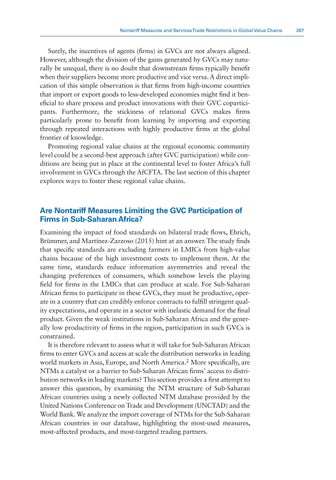Nontariff Measures and Services Trade Restrictions in Global Value Chains 287
Surely, the incentives of agents (firms) in GVCs are not always aligned. However, although the division of the gains generated by GVCs may naturally be unequal, there is no doubt that downstream firms typically benefit when their suppliers become more productive and vice versa. A direct implication of this simple observation is that firms from high-income countries that import or export goods to less-developed economies might find it beneficial to share process and product innovations with their GVC coparticipants. Furthermore, the stickiness of relational GVCs makes firms particularly prone to benefit from learning by importing and exporting through repeated interactions with highly productive firms at the global frontier of knowledge. Promoting regional value chains at the regional economic community level could be a second-best approach (after GVC participation) while conditions are being put in place at the continental level to foster Africa’s full involvement in GVCs through the AfCFTA. The last section of this chapter explores ways to foster these regional value chains.
Are Nontariff Measures Limiting the GVC Participation of Firms in Sub-Saharan Africa? Examining the impact of food standards on bilateral trade flows, Ehrich, Brümmer, and Martínez-Zarzoso (2015) hint at an answer. The study finds that specific standards are excluding farmers in LMICs from high-value chains because of the high investment costs to implement them. At the same time, standards reduce information asymmetries and reveal the changing preferences of consumers, which somehow levels the playing field for firms in the LMICs that can produce at scale. For Sub-Saharan African firms to participate in these GVCs, they must be productive, operate in a country that can credibly enforce contracts to fulfill stringent quality expectations, and operate in a sector with inelastic demand for the final product. Given the weak institutions in Sub-Saharan Africa and the generally low productivity of firms in the region, participation in such GVCs is constrained. It is therefore relevant to assess what it will take for Sub-Saharan African firms to enter GVCs and access at scale the distribution networks in leading world markets in Asia, Europe, and North America.2 More specifically, are NTMs a catalyst or a barrier to Sub-Saharan African firms’ access to distribution networks in leading markets? This section provides a first attempt to answer this question, by examining the NTM structure of Sub-Saharan African countries using a newly collected NTM database provided by the United Nations Conference on Trade and Development (UNCTAD) and the World Bank. We analyze the import coverage of NTMs for the Sub-Saharan African countries in our database, highlighting the most-used measures, most-affected products, and most-targeted trading partners.


